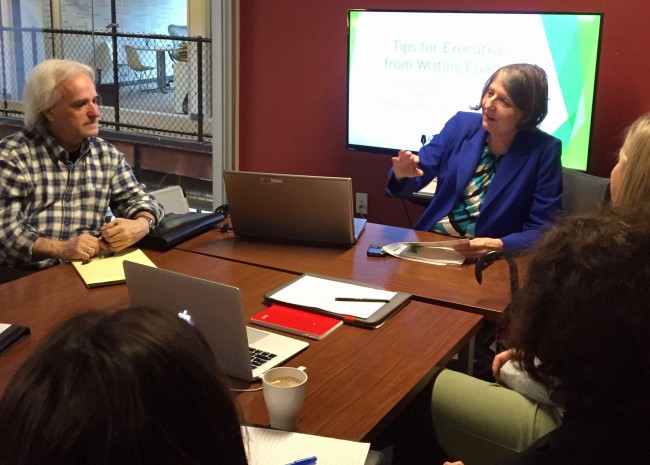
Writing Tips for Business Leaders from Writing Coaches
By Sue Stoney, the Message Crafter
Photograph taken by Molly Walker, Walker Communications
The five sets of tips I’m sharing with you here come from my own experience, as well as from my colleagues, fellow members of the San Francisco chapter of IABC (International Association of Business Communicators), who write, edit and / or coach others’ writing that supports the business bottom line. These tips are an expansion on a blog article I posted on my website in June 2016, “The Power in Collaboration: 5 Things I Learned in 2 Years Coaching Others’ Writing”.
What My Career as a Writing Coach Has Taught Me
I was a writer, editor and writing coach at 4 different companies in 4 different industries for 25 years. I helped geeks and nerds (subject matter experts – SMEs for short) develop content that sold their company’s products and services. These men and women got where they were by being individual contributors to their company’s success. And now, as the owner of my company, I’ve been helping geeks and nerds, primarily small business owners but also some individuals, develop content. I’ve found that…
- …corporate executives and business owners have at least 6 things in common…
1) Leadership skills 2) A subject matter expertise that got them where they are 3) Confidence in decision-making 4) Humility that tempers the confidence (ownership of the decisions versus ego) 5) Understanding of and appreciation for the skills and abilities of the team and how they complement the leader’s 6) Willingness to take calculated risks
- …and one important difference: what “entrepreneurial” means in the corporate world when compared to an individually owned business
An entrepreneur, especially a solopreneur, has a more direct line of sight with respect to his or her actions as they affect profitability than a corporate leader does. Corporate leaders find that they need to be more diligent about maintaining that line of sight.
Leaders in both circumstances CAN make money and carry forward humankind at the same time.
Tip 1. Balance Personal Ownership with Team Effort for Every Writing Project
- The responsibility is all on me, but…
- …other people can (must) contribute
- The collaboration imperative: Know your strengths compared to those of others
J. K. Rowling’s turning point in her writing career came when she began to tell herself “I am a writer. Writing is the way I make my money.” Do you see yourself as a writer? Do you act like it (that is, are you writing as if it matters)?
Ego gets out of the way when leaders acknowledge their weaknesses / strengths and look to other people’s strengths to complement their own. In her seminal work, The Progress Principle, Dr. Teresa Amabile tells us that employees’ primary motivation is to be involved in meaningful work and regularly make progress in it.
If a writing project is a collaboration, it will produce a stronger end product than if a single person wrote it…provided that everyone contributing to the project is coming from a place of personal strength. If the writing project is an inter-departmental effort, approach it with a “re-use, re-purpose, re-cycle” mentality for a successful outcome that ensures a primary “authorial voice” appropriate to the piece.
Ask yourself at every stage: How does my subject matter expertise interrelate with that of others on this writing project?
Tip 2. For Every Writing Project, Always Answer 3 Questions
- Who is going to read this communication?
- Why are we writing THIS NOW?
- How does this communication piece contribute to the company’s bottom line?

The answers to these four questions will help determine:
- What we expect the readers to do
- Whose authorial voice needs to dominate
- Whether we’re going to re-use, re-purpose, re-cycle “boilerplate” copy. Whose “boilerplate” is it? This determines the dominant authorial voice. Or do we need to “write from scratch”? (Rewriting uses different skills than writing original material. Who has expertise in each?)
- How we can incorporate the expertise of a language and messaging SME on the project. Who IS our language and messaging expert? (In other words, who’s going to watch for use of jargon, acronyms, initialisms, “technical-ese” and “marketing-ese”, and balance the expert’s voice with the teacher’s?)
The dollar sign in the middle of the triangle graphic represents the bottom line, and the content we produce must always connect to the bottom line.
Tip 3. Be Proactive in Dealing with Writer’s Block
Focus on the source of the block; where is it coming from; what does it look like? Is the source of the block me? My insecurity? My ego? Am I writing from a place of strength – the juncture of what I am good at and what I love? How can I plug into that? Is the block someone else working on the project?
Try capturing what you need to say on tape. Tape whatever comes into your head. Then transcribe it onto the page (and self-edit as you go).
Read someone else’s writing you admire. Focus on excellence in the process. When you read others’ work, think: “Oh, that’s a great turn of phrase!” or ask yourself, “What tone of voice, what word choices, what phrases, what types of communication will get my creative juices going…and get others to sit up and take notice of my writing?”
As the Nike commercial used to say, “Just do it.” Remember what I said earlier about J. K. Rowling’s career turning point? If I see myself as a writer, I just do it. (This is how I make all or most of my money.) I often tell my clients to write on momentum…until they run out of juice.
When you find a natural stopping point, close out of the writing project and walk away. Norman Mailer has been quoted as saying, “If you tell yourself you are going to be at your desk tomorrow, you’re asking your unconscious to prepare the material.” Let your unconscious “chew on” what you’re writing before you start on it and/or get back to it.
When you come back to your writing, you will see it with a fresh pair of eyes. Read it out loud as you review it with an editor’s eye – as if you were doing the voice-over for an audio book.
Tip 4. Build Your Business through Content Marketing
Ask yourself: Is the business I’m in my sweet spot (what I’m good at; what I love)? Writing about the business we love and are good at is called content marketing. This question applies to corporate people AND business owners. What our English teachers told us is true: We write best about that which we excel at and enjoy doing. Stand in your excellence as a subject matter expert, and they will come…but first you have to show them you know what you’re talking about.
What is content? Content is the stuff you know helps sell your company’s products and services. It is the stuff of your everyday work life. It is about what you are an expert at.
What is marketing? Marketing is the way you let people in on the expertise you and your company have that they need.
How do “content” and “marketing” fit together? If the content and marketing are perfectly matched, people will see you, not as Willy Loman with his foot caught in their door trying to sell them something they don’t want or need, but as a knowledge leader who offers them what they are willing to pay for. Anything you write needs to connect to your business’ bottom line. It should contain free-will gifts of SOME of your content to establish your credentials in the field.
Tip 5. Make Your Writing the Best It Can Be
Use graphics that capture the essence of the words. A mentor of mine when I first started in proposal development referred to this as the perfect marriage of text and graphics. Resist the temptation to include pictures simply to make a piece pretty. Ensure that the quality of those graphics matches the level of discourse in the text (and that you have appropriate permission to use them).
Have ready access to an online (or paper copy) thesaurus to make the sharpest word choices you can. Have whatever you’ve written read by at least one other person. And re-read it yourself before you hit “Publish”, “Send” or “Post”.
Remember that tip to write on momentum and then come back to the draft to edit it? I call this “clearing your mental palate”. You close out of the file, walk away and come back to it because you need to distance yourself from the writing. And, if you aren’t the SME who knows about the finer points of copyediting (grammar, syntax, punctuation and spelling), ensure that one of the readers of your piece is.
Are you one of those people who doesn’t necessarily see the importance of an edit review for these kinds of details? Consider the story of a typo that cost someone 6 figures’ worth in an eBay auction. The full version of the story is on the Six Degrees website, but here’s the short form:
An initial eBay auction for a 155-year-old bottle of Allsopp’s Arctic Ale was missing that all-important second “p” in the brewer’s brand name. As a result, it garnered only two unique offers, the winning one being $304. You might think that was good money for a single bottle of beer – until you hear that the revised post, with an updated description (correctly spelling the brand name), caused a bidding war, and the owner who paid that $304 accepted a final offer of more than half a million dollars.
And This Final Imperative about Learning to Write Well…
If you want to build your writing muscles, you must read to write and write to read.
I encourage SME writers to read fiction and non-fiction, to study the word choices, character development, scene setting, phraseology, text flow, and story-telling techniques of the masters. I coach them to believe that their writing skills will mature as they use them.
Practice makes better and better.
